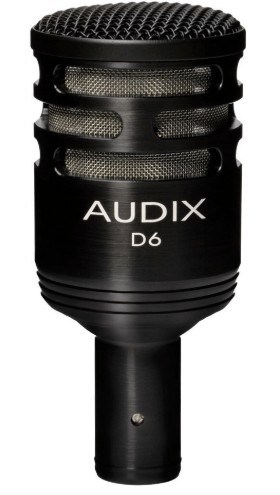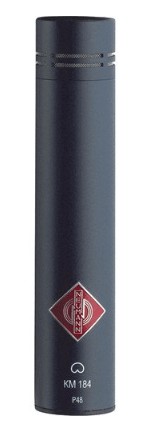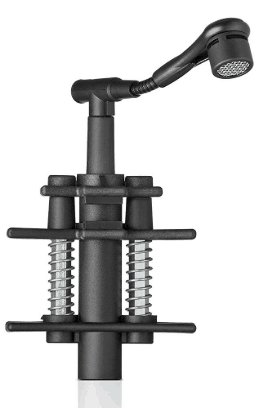Miking drums for live performance can be very tasking, but miking drums for a home studio recording, that's another ball game entirely. It requires detailed preparation. That's why even picking out the mics to use is an important step.
| Product | Frequency response | Maximum SPL | Amazon product page |
| Audix D6 | 30Hz to 15000Hz | 144 dB | Check price |
| Shure SM57 | 40Hz to 15000Hz | 149 dB | Check price |
| Sennheiser E604 | 40 to 18000Hz | 160 dB | Check price |
| Neumann 184 MT | 20Hz to 20000Hz | 138 dB | Check price |
| Beyerdynamic TG-D58C | 20Hz to 20000Hz | 140 dB | Check price |
We have made a guide list that can be a good starting point for you. This article shows you our top 5 picks for home studio drums recording. We didn't just make a list for you, we explained why each product deserves to be listed.
We arrived at our best drum mic picks after considering the limitations faced by home studio producers and drummers and also noting the advantages you can benefit from. Lastly, we know what home studio budgets look like, so we have tailored our picks towards that.
What to look for while buying a drum mic?
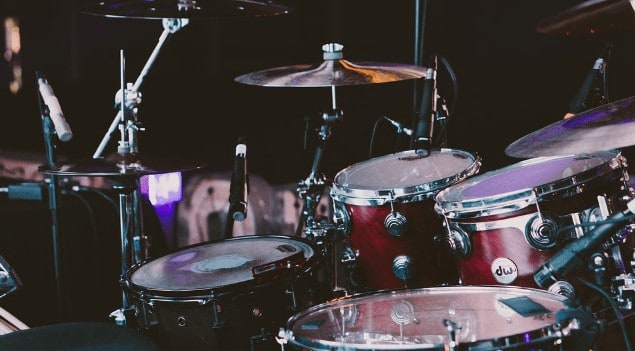
Room acoustics
If you're buying a drum mic for recording purposes, your room acoustics is the first thing you must consider. For most home studios, in terms of acoustics, we just try to make the room as best sounding as we can.
If your room still has some unwanted reflections, you need to go for mics with lower sensitivity figures. If not your recording will be marred with reflected sound.
Number of mics
The number of mics you wish to use in recording drums determine what direction you'll look. If you plan to use two mics to capture the whole kit, you may need to go for high sensitivity condenser mics, with wide frequency response.
On the other hand, if you prefer to mic each piece individually,you'll be looking at between four and six pieces of mics.
Available space
This includes space around the room and even above the drummer. This would determine if you should go for clip-on mics or handheld mics on stands. Using clip-on mics would mean that you will use less stands, occupying less space.
Also, the space above the drummer is necessary for overhead mic placement. It's important that there's considerable height distance between overhead mics and the cymbals. However, this means that the ceiling must be treated for reflections too, if they're not high enough.
Work process
Here, you only need to answer a simple question.
Do you intend to record the drums separately, or will you be recording drums together with the rest of the band?
If you're recording the drums separately, you have more freedom of choice, buy if you intend to do a full band live recording, go for dynamic cardioid mics only. This way you can limit the sound captured by drum mics to drums alone, to a large extent.
Here are our top picks for drum kit mics:
#1. Audix D6
Build and design
At first glance, you get drawn to the Audix D6 microphone because of its shape. It has quite a unique shape; like a wider cylinder right on top of a narrower one. It's also quite light, weighing just 7.7 ounces.
That being said, the part of the Audix D6's build that makes it a good drum mic is it's strong body.
Made from machined aluminium, the grille is a steel mesh that ensures that accidental drops do not prove fatal. A drum mic needs to be at least rugged enough to withstand occasional hits from drumsticks. The Audix D6 design has this covered.
It is connected to the mixer by means of the XLR port at the base of the mic. Additionally, it's a dynamic mic, which means it probably wouldn't pick a wide range at once, which is also a good quality of a drum mic.
Lastly, the D6 is a cardioid mic. This polar pattern means that the mic can easily reject off-axis or unwanted sound.
Sound quality
The Audix D6 has a frequency response of 30Hz to 15000Hz. Just by looking at the frequency range, you can know what drum parts it'll work well with; kick drums and floor toms.
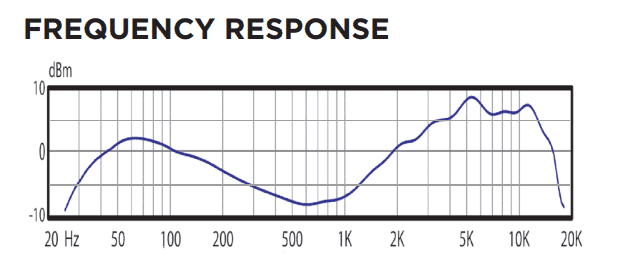
Also, I should say that the 30Hz lower frequency boundary isn't a mere figure; the D6 is really the king of the low end. In addition to that, there's a big dip in the frequency response diagram, between 200Hz and 2kHz.
Merely looking at the diagram, you would think that the dip would be so audible, but listening to the sound, it seems more like it was carefully calculated to capture enough bass and drop the response, only to increase it when the thump or snap would be needed.
Of course, you may need a different character, depending on the genre you're working with. However, this is a good starting point for both drummer and sound engineer.
Pros:
- Compact design, light weight
- Solid build
- High SPL; good for loud volumes
Cons:
- Only good for parts of the drum; not versatile.
Bottomline
This mic is very good for the kick drum and floor toms; you can be sure that the low end will be properly represented.
#2. Shure SM57
Build and design
It's not an exaggeration when I say the Shure SM57 is the most popular pro drum mic in the world.
It is the poster microphone for many recording engineers when working with Percy musicians; from home studios to professional commercial recording facilities. SM57 is also the best mic you can use in the untreated rooms and for recording pianos.
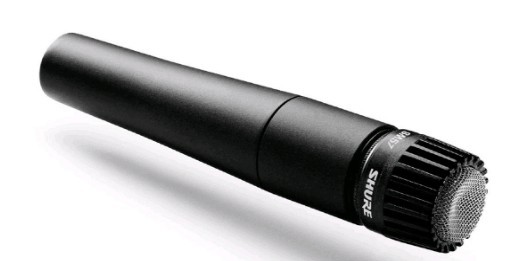
The SM57 did not gain this reputation overnight, and the reasons for its unprecedented popularity are not far-fetched.
First, it not only looks and feels rugged, it IS rugged. The Shure SM57 has a narrow, unassuming but quite solid build that makes it withstand the use and abuse of a drum mic, and keep going for years.
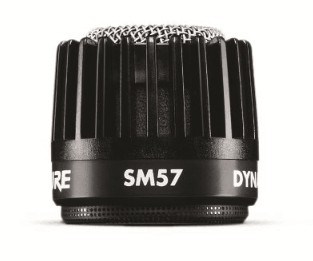
Connected via XLR cable, the SM57 can be used to mic snares and toms, although it's most popular with snares.
Measuring about half a foot long and weighing 10.1 ounces, this mic's strength was tested by dropping it 10 times from a height of ten feet. Even at that, there was no drop in quality.
Sound quality
Asides from the build, another reason the SM57 is a snare drum favorite is its maximum SPL.
For some reason, they did not indicate it in the spec sheet, which is surprising, because in practical use, no drummer can play a sound loud enough to create distortion with the SM57.
You would need a something as loud as 180db to reach this mics breaking point–even heavy metal drummers can't play that loud.
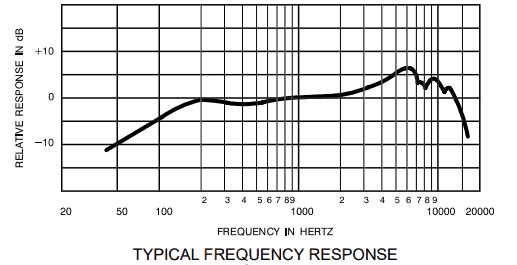
Also, the Shure SM57 has a frequency response of 40Hz-15000Hz; good enough for the snare drum and toms, but may not be as effective for hi-hats and cymbals. This mic is one of the greatest value-for-money situations I've seen; you get quality for every dollar you spend on it.
Pros:
- Rugged and long lasting
- High SPL; can take any drum sound thrown at it.
- Captures the snare drum efficiently.
Cons:
- May need to be paired to capture the whole snare sound (top and bottom)
- Could sound too snappy when playing with brushes.
Bottomline
Obviously, the SM57 is king of the snare drum, and it will probably last longer than your drums. Good choice for the long haul.
#3. Sennheiser E604
Design and build
The E604 is a cardioid dynamic drum microphone. The most obvious feature of this mic is probably its size.
It's very compact and designed to be clipped on the rim of the snare and toms. This will be a pretty good choice if you don't have so much space for mic stands. However, don't be fooled by the size, this mic is a rock, definitely built to take the rigors associated with drum mics.
The clips are quite flexible, giving you a reasonable amount of freedom to choose angle and placement. Also, the clips work with all types of drums, so long as there's a rim to which you attach them. It connects to the mixer or audio interface via an XLR cable.
The body is made of reinforced glass-fibre, one of the most rugged materials in modern manufacturing. It'll be pretty hard for any impact on the mic to affect internal parts.
Sound quality
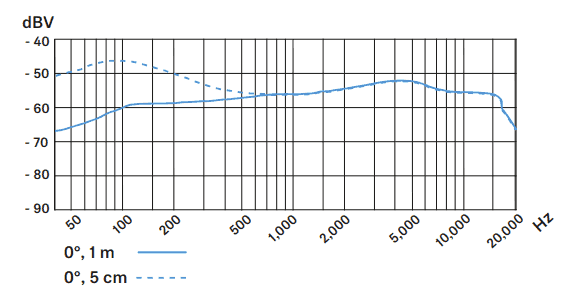
With a maximum SPL of over 160, no normal drummer should have distortions from this mic while recording (emphasis on normal). It has a frequency response of 40 – 18000Hz. On paper this is wide enough to do a good job of recording the snare and tom properly.
Better still, this potential is replicated in practice; the e604 records the vibrating wires properly when placed under the snare, and also does a pretty accurate job when brushes are used.
Because the mic is clipped to the drum, you would expect some of the vibrations to find its way into the recording.

Well, Sennheiser thought of this too, and they made sure that the handling noise is as low as possible. Also, being a cardioid polar pattern dynamic mic, it does well in rejecting sounds not directed at it.
Pros:
- Easy to set up; just clip it to the drum.
- Low impact noise
- Less bleed since it's close to the drums
Cons:
- Less freedom of mic placement.
- More prone to stick hits
Bottomline
If you want to record drums, you should first consider drum-specialized mics before others. The Sennheiser e604 is one of those.
#4. Neumann 184 MT
Build and design
This is the black version of the Neumann KM 184 condenser microphone. This mic ticks most of the boxes for a good drum mic. The design, size and weight makes it easy to position this mic without getting in the way of the drummer while recording.
It weighs just 80 grams and it's 10.7 cm long. The KM 184 MT has a cylindrical shape, with uniform diameter from top to bottom of the mic. I think this Neumann mic has one of the best combinations of sleek and solid.
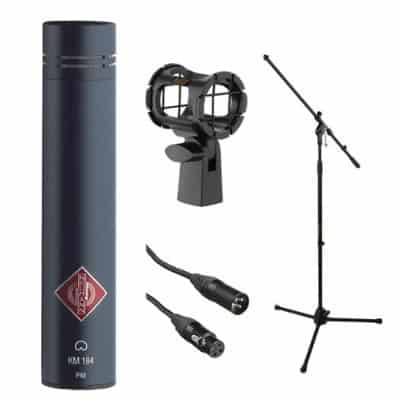
It looks so beautiful and feels so sturdy at the same time. The makers say call this color matte black; I guess that's where the "MT" came from. It's connection is via the XLR port located at the bottom.
It requires 48-volt phantom power to work. Most decent mixers or audio interface can provide enough power for this.
Sound quality
The frequency response of 20Hz to 20000Hz suggests that the KM 184 MT can be used to record any of the drum parts. Of course you can, but it is better suited to some drums than others.
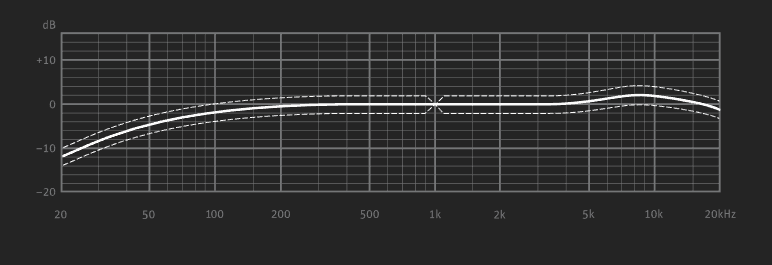
The KM 184 's frequency response chart shows a lift at 9000Hz and continues till around 16000Hz. This frequency characteristic makes the mic add some presence and clarity to what you're recording.
Additionally, Neumann KM 184 MT is a cardioid microphone, which makes it a good choice for a drum mic, since it does a good job at rejecting unwanted sound.
Pros:
- Sleek, attractive design
- Adds brightness to hi-hats and cymbals
- Has enough range to be used as overhead mics
Cons:
- May not be perfect for kick drum
- Ineffective without phantom power.
Bottomline
While some engineers and producers prefer to record drums with dynamic microphones, the KM 184 does a good, clean job, which makes is a top choice for recording hi-hats, cymbals and as overhead mics.
#5. Beyerdynamic TG-D58C
Build and design
The Beyerdynamic TG-D58C is a clip-on condenser microphone with a cardioid polar pattern. Its clip is quite unique; allowing for a considerable amount of freedom.
The clip-on system is larger than the mic itself. This is a good thing because it gives you more freedom to position the mic at vantage positions, especially when you don't have enough to go round all the drum pieces.
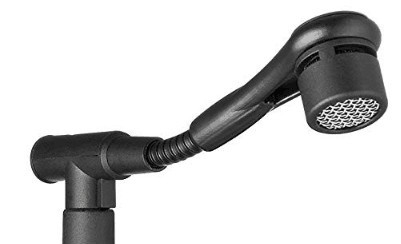
For instance, if you're recording drums with a rack of toms, you may want to clip the mic on and place it such that it captures sound from up to 3 toms.
The way the mic sits on the frame is iconic; it looks a bit like a parrot perched on a branch.The mic head is quite tiny, linked to its XLR port by the tube-like body.
The frame that clips the mic is a sturdy figure that allows you to have much distance between the mic head and the drum surface.
Sound quality
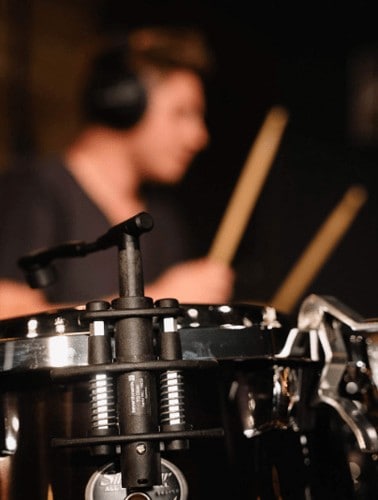
The TG-D58C has a wide frequency response; with the low frequency boundary between 20Hz and 35Hz depending on your placement distance from the source. The high frequency reaches up to 20000Hz, which is good enough for snares .
There's a lift in response between 2k Hz and 5kHz, that continues to rise until it peaks at about 10kHz. This is responsible for the presence and clarity heard when recording snare drums with it. However, at higher gain levels, you can hear a bit or resonance, mostly due to the frequency response too; nothing a little eqing can't fix though.

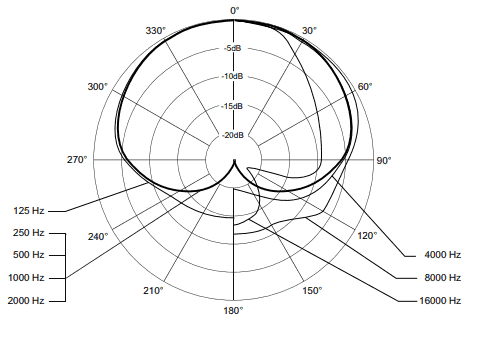
It has a maximum SPL of 140db, which some drummers and engineers would argue is a bit low. Some genres and drummers may need more headroom. However, since the mic's design gives room for more distance in placement, you can compensate for this while positioning the mic.
Pros:
- More freedom of mic placement
- Wide frequency response to accommodate snare inflections
Cons:
- Bulky clip-on system
- Maximum SPL could be higher.
Bottomline
The Beyerdynamic TG-D58C is good enough for recording your drums, especially if you don't have enough mics to go round each piece in the set. Quality sound too.
FAQs on drum kit mics for home recordings
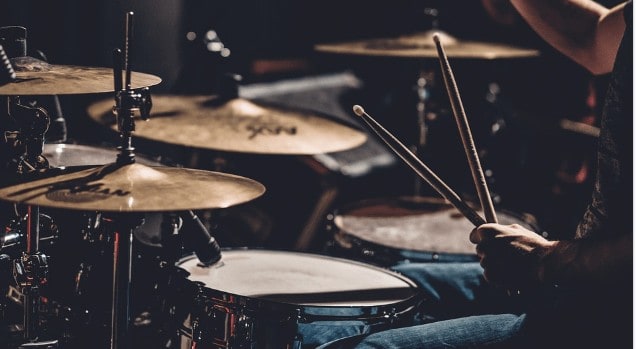
- How to Mic a Drum Kit?
First of all, what sounds are we trying to capture?
The parts common to every drum set are the kick, snare, hi-hat, toms and cymbals.The kick drum has two sounds fused into one: The low frequency body of the kick, and the mid frequency thwack or snap sound the drum makes when the pedal connects.
For the snare, you must capture not just the obvious snap the of the stick hitting the surface, but also the vibrations in those wires at the bottom and resonance that comes after.
2. Does a good drum mic require a big budget?
No. Although, that would depend on what's "big" to you. Nevertheless, relative to general studio equipment prices, I would say you don't have to break the bank to mic your drums. There are averagely priced good microphones out there.
Also, even if you can't mic every piece of your drums, you can go for two-mic setup options. Lastly, before you buy any drum mics, be sure of what you want to use them for, because the best drum mics for live sound may not be very good for studio recording.
3. Which is the best drum mics for recording?
Off the top of my head, I'd say any Shure complete drum mic kit. The reason is simple: They've been in the business for so long, they can't have bad drum mics. If your budget can accommodate it, you can combine these with neumann condenser mics for your cymbals and overheads.
4. Which is the best drum mics for live sound?
Again, Shure complete kits, you can't go wrong with those. You can use the Sennheiser e604 for the bottom of the snare if you need more detail. Also, Neumann KM 184 for hi-hats and cymbals.
5. What is the difference between overhead drum mic and kick drum mic?
Overhead drum mics have two jobs. The first is to capture sound from cymbals. Because of the nature of cymbal sounds, you can't have close miking for them, it just won't work, hence the overhead mics.
The second function of overhead mics is to capture the sound of all the drums, together with some room ambiance; it gives the recorded material a more natural feel, rather than just a dry recording.
Read our other popular posts:
- Best Mics for Female Vocals for Live Stage Performance
- Only 3 Best Beatboxing Mics for Live Performances in 2025
- The Only 3 Best Microphones for Violin Recording in 2025
- The Only 3 Best Flute Mics For Live Performances and Studios
Conclusion
Even though there are different parts to drums, we have managed to touch every single one with our selections. You must pay attention to every detail if you're recording drums. For live sound, you may gloss over some tinier detail, but when recording it's not the same.
The thing with a studio recording is, people will listen to the song over and over, so if you miss a detail, they eventually notice.
They may not know what it is, but they just know something is off. For a live performance, people don't care as much.
So, it is important that you choose your tools wisely when recording drums. Thankfully, we've made you a superstar lineup to start with.


